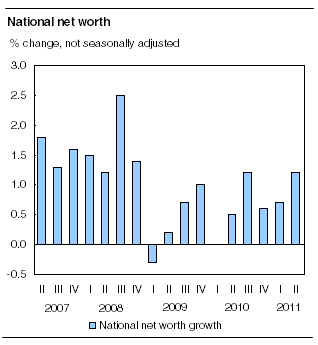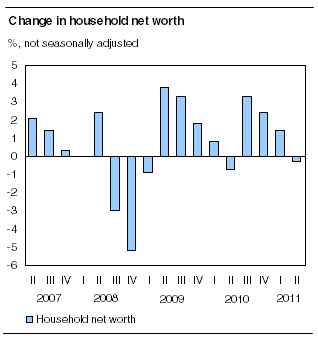National balance sheet accounts
Archived Content
Information identified as archived is provided for reference, research or recordkeeping purposes. It is not subject to the Government of Canada Web Standards and has not been altered or updated since it was archived. Please "contact us" to request a format other than those available.
Related subjects
-
[an error occurred while processing this directive]
National net worth increased 1.2% to $6.4 trillion in the second quarter. On a per capita basis, national net worth was $186,900 in the second quarter, up from $185,300 the previous quarter.
Among non-financial assets, residential real estate remained the major contributor to the increase in national wealth during the quarter, accounting for over half of the gain.

Chart description: National net worth
Drop in share values reduces household net worth
Household net worth fell 0.3% in the second quarter, as the increase in the value of residential real estate was more than offset by the decline in the value of household holdings of equities (including mutual funds) and pension assets. The Standard and Poor's / Toronto Stock Exchange composite index fell 5.9%. Per capita household net worth fell from $185,500 in the first quarter to $184,300 in the second quarter, marking the first decline since the second quarter of 2010.
Note to readers
Canadian publicly traded companies have begun their transition to International Financial Reporting Standards in the first quarter of 2011. As all companies adopt the new reporting standards over the next quarters, this will have an affect on the National balance sheet accounts (NBSA). For more information on some of these affects, consult the article "Impact of new accounting standards on the financial and wealth accounts".
The NBSA comprise the balance sheets of all sectors of the economy: the persons and unincorporated business (households), corporate, government, and non-resident sectors. They cover all national non-financial assets and financial claims and their associated liabilities outstanding in all sectors.
National net worth is national wealth less net foreign liabilities (that is, what is owed to non-residents less what non-residents owe to Canadians). Alternatively, it is the sum of the net worth of the persons and unincorporated business, corporate, and government sectors.
Household credit market debt comprises consumer credit, mortgage, and loan debt of households, non-profit institutions serving households, and unincorporated businesses.
Corporate equity is treated as a liability on the balance sheet of the corporate sector since it represents a claim by shareholders on the corporate sector. As a result, as equity prices increase, corporate net worth will tend to decline, reflecting the increase in the corporate sector's equity liabilities.
Quarterly series, at both book and market value, are available from the first quarter of 1990. Annual market value data are published from 1970, while book value estimates remain available from 1961. Marketable securities are at market value, unless otherwise stated. For more information on the market value estimates, consult the National balance sheet estimates at market value page of our website.
Important changes are coming to Canada's System of National Accounts (CSNA), starting in May 2012. These changes will affect all users of CSNA products and statistics such as gross domestic product, balance of payments, international investment, and input-output tables.
For more information, consult the Canadian System of National Accounts 2012 Historical Revision.

Chart description: Change in household net worth
Credit market debt of the household sector grew in the second quarter, as a result of both higher mortgage and consumer credit borrowing. The ratio of household credit market debt to personal disposable income ratio was up, as debt levels grew faster than the growth in personal disposable income. The debt-service ratio was unchanged from the previous quarter at 7.5%. Home owners' equity as a percentage of real estate assets edged down further in the second quarter, as the credit market debt to net worth ratio increased for the fourth straight quarter to 24.4%.

Chart description: Household sector debt indicators
Government net debt up
Overall government net debt (expressed at book value) increased to $772 billion in the second quarter from $753 billion the previous quarter. The ratio of net debt to gross domestic product rose from 45.7% in the first quarter to 46.3% in the second quarter. Bonds led the increase in total government debt in the second quarter, with significant net issues for both federal and provincial governments.
Corporate debt to equity edges up
Debt financing by private non-financial corporations edged up while equity issuances slowed. Total credit market debt to equity (expressed at book value) increased from 54.2% in the first quarter to 54.9% in the second quarter.

Chart description: Corporate debt to equity
Overall total asset growth of institutional investors (such as trusteed pension plans and mutual funds) slowed in the second quarter. The value of investments in shares decreased in the second quarter. This was offset by an increase in the value of holdings of federal and provincial government bonds.
Available on CANSIM: tables 378-0012 to 378-0014 and 378-0049 to 378-0116.
Definitions, data sources and methods: survey number 1806.
The National economic accounts module, accessible from the Key resource module of our website, features an up-to-date portrait of national and provincial economies and their structure.
The second quarter 2011 National Balance Sheet Accounts: Data Tables, Vol. 4, no. 2 (13-022-X, free), is now available from the Key resource module of our website under Publications.
Additional tables and links to other releases from the national accounts can be found in the second quarter 2011 issue of Canadian Economic Accounts Quarterly Review, Vol. 10, no. 2 (13-010-X, free). This publication is now available from the Key resource module of our website under Publications. Revised estimates of the National balance sheet accounts for the first quarter of 2011 have been released along with those for the second quarter of 2011. These estimates incorporate new and revised source data and updated estimates of seasonal patterns.
Data for the third quarter will be released on December 13.
For more information, or to enquire about the concepts, methods or data quality of this release, contact the information officer (613-951-3640; iead-info-dcrd@statcan.gc.ca), Income and Expenditure Accounts Division.
- Date modified:
